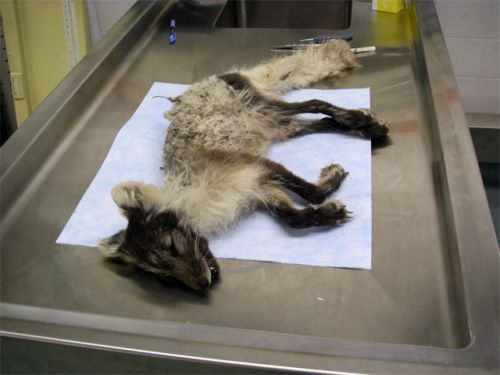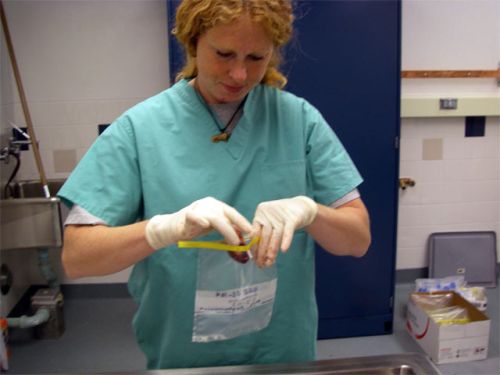This journal entry is about a scientific procedure known as necropsy, or the medical examination of a dead animal. The text and pictures that follow may be offensive to some. I hope you find it informative.
I walked down past our lab today and into another lab, the Necropsy Lab. A nice lab with lots of stainless steel sinks and counters. A faint odor is present, hard to describe, a little like a dissection lab, with a slight hint of dead animal.
 Necropsy is the same as an autopsy except it is done with an animal. The goals are the same, to investagte the animal and learn more about how it lived, how it's body was working, and how it died.
Necropsy is the same as an autopsy except it is done with an animal. The goals are the same, to investagte the animal and learn more about how it lived, how it's body was working, and how it died.
I meet Greta Krafsur, a student at Colorado State University, who is very busy up here at Barrow Arctic Science Center conducting necropsies on different arctic animals. Her task is to examine the dead animals to learn more about their general health by looking both at organs as well as at tissue samples.
I also meet an 8lb. female arctic fox that was trapped and killed. The reason she was trapped was because the arctic foxes are eating the eggs of an endangered species, the Steller’s eider. The US Fish and Wildlife theory is that fewer fox in the area will give the population of the eiders a chance to rebound.
 This fox was trapped on June 2, 2008. Scientists believe that generally only sick or injured animals are captured in traps. Trapping this population then helps the rest of the group stay healthier while also giving scientists a chance to examine disease and the effect it is having on the animal.
This fox was trapped on June 2, 2008. Scientists believe that generally only sick or injured animals are captured in traps. Trapping this population then helps the rest of the group stay healthier while also giving scientists a chance to examine disease and the effect it is having on the animal.
The arctic fox are remarkable animals. Their fur changes from white in the fall to grayish brown in the spring. Thick fur, rumored to be the warmest of any mammal, covers their rounded body as well as their feet. Typically, arctic fox spend most of their time eating lemmings, voles, and hares. Occasionally, they will eat carrion, dead animal pieces, left behind by a polar bear or another animal. Their goal, similar to all arctic animals, is to store enough body fat during the short summer season to make it easier to survive the long, cold, winter.
 The arctic fox has furry paws to keep it's feet warm and to allow it to move quickly over the snow and frozen ground.
The arctic fox has furry paws to keep it's feet warm and to allow it to move quickly over the snow and frozen ground.
Greta readies her tools, paperwork, and puts on two layers of latex gloves, explaining what she is doing as she goes along. It is clear, she likes this job; "I don’t even consider it work.” Greta mentions.
First task, quick check of the animal, looking for signs of injury, or trauma. Collect fur samples.
 One of the first things you do during a medical exam of a human or of a n animal is that you look at the entire animal noting anything unusual.
One of the first things you do during a medical exam of a human or of a n animal is that you look at the entire animal noting anything unusual.
Next, take a few measurements, make a few notes.
 Greta takes notes on all the different discoveries she makes. She then takes her notes and types tham up, she knows her writing is not very clear.
Greta takes notes on all the different discoveries she makes. She then takes her notes and types tham up, she knows her writing is not very clear.
Next up, begin by making an incision, a cut, along the side of the jaw, pulling back on the skin tissue as you go, trying not to cut or slice any muscle tissue. At one point, I hear Greta exclaim, "Oh, I hate to cut that beautiful internal thoraxic artery!!’
 The first task for Greta is to separate skin from underlying muscle tissue. She explains the different muscles and fatty tissues she see as she works quickly along.
The first task for Greta is to separate skin from underlying muscle tissue. She explains the different muscles and fatty tissues she see as she works quickly along.
 Greta was taking samples in two ways, one for determining general health and well being, the other for examination of tissues and specific cell characteristics.
Greta was taking samples in two ways, one for determining general health and well being, the other for examination of tissues and specific cell characteristics.
From the first incision to the last, Greta is professional and respectful. She knows that the science is needed and hopes it will be helpful not only for the foxes but also for domestic animals too. Her plan is to become a Veterinary Anatomic Pathologist. I now know more about what that career involves. Thanks for taking the time to explain things so well, Greta.
For all the arctic foxes out there, stay away from the eider eggs and the leg hold traps. You are too beautiful for the necropsy lab.

